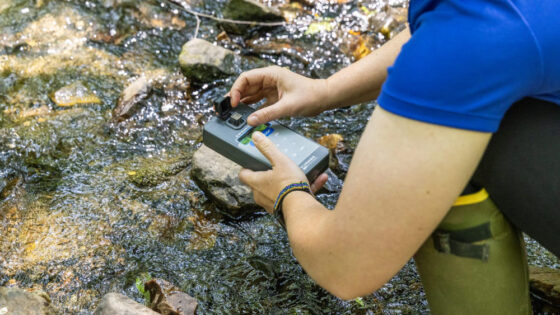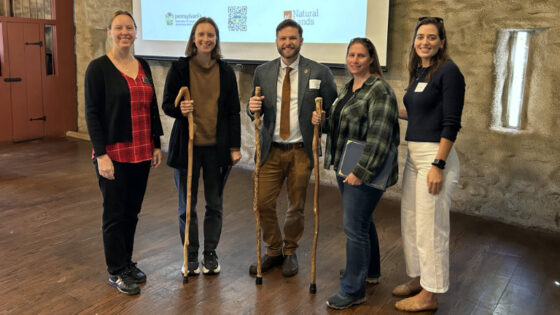Scientists Discover Threats to National Park Streams and What Park Managers Can Do About Them
By Daniel Myers, Ph.D., and Diane Huskinson
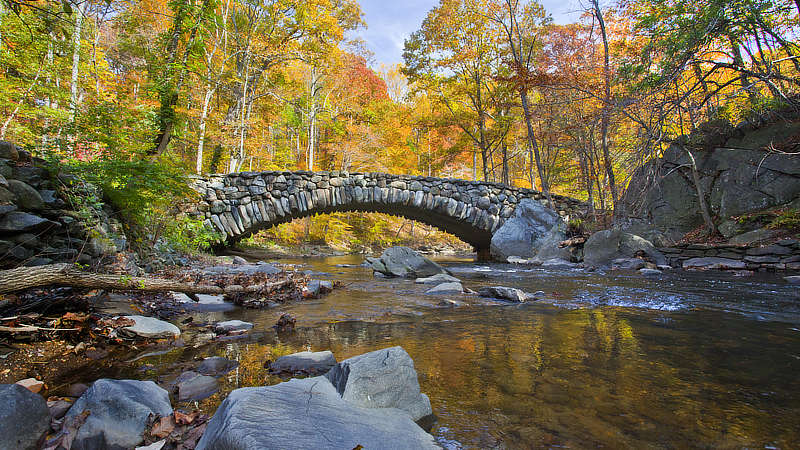
U.S. national parks are among the most treasured public outdoor spaces in the nation and even the world, drawing hundreds of millions of visitors to more than 400 parks annually. Within a couple hours’ drive from Washington, D.C., are some of the most cherished and visited among them: visitors can exercise in the winding
D.C. cityscape of Rock Creek Park, be mesmerized by the cool bubbling brooks of Maryland’s Catoctin Mountain Park, and explore endless trails through the deciduous lowlands of Virginia’s Prince William Forest Park.
People were reminded of the value of these parks during the height of the coronavirus pandemic, when isolation, lockdowns, and the fear of crowded indoor quarters brought an overwhelming urge to reconnect with the great outdoors.
In times of stress, national parks provide a sanctuary from the rush and clamor of everyday life. In times of celebration, they offer a pleasing backdrop for hikes, picnics, bird watching, bike rides, and fishing with friends. Without them, there would be few places where people of any means or background could still discover the vast and wild beauty of nature.
“If it weren’t for these places, we would have forgotten what these landscapes used to look like and what we have actually lost elsewhere,” says Marc Peipoch, Ph.D., assistant research scientist at Stroud Water Research Center.
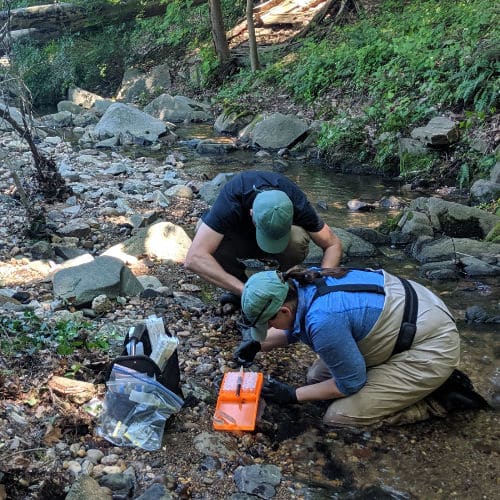
Yet as wonderful as national parks are for solace and recreation, they can be equally valuable as ecological refuges for vulnerable fish, wildlife, plants, and water resources — if they are properly cared for.
“We naively think of national parks as having pristine, undisturbed streams,” says Diana Oviedo Vargas, Ph.D., assistant research scientist at the Stroud Center. “However, stream ecosystems in national parks can be vulnerable to certain land uses and climate change, particularly when a stream’s watershed extends beyond park boundaries.”
To ensure the long-term conservation of national parks, including the streams that flow through them, park managers must know what ecological resources exist in the parks, what condition they are in, and how they are changing, for better or worse, over time.
Enter the Inventory & Monitoring (I&M) Division of the National Park Service. Established in the 1990s, this science-focused division encompasses 32 networks of parks across the United States.
In the National Capital Region, I&M has collected more than 15 years of water quality and biological data. However, limited in-house expertise in hydrology and aquatic ecology has made it challenging for I&M to analyze stream data and provide conclusions that would help park managers make informed decisions about aquatic resources.
A Collaborative Approach
Through cooperative agreements with the park service, the Stroud Center has been collaborating with I&M in the National Capital Region to support monitoring and analysis of park stream ecosystems.
Starting in 2019, Stroud Center scientists Stephanie Bernasconi, Laura Zgleszewski, and Kristen McCarthy spent a few weeks each summer wading into park streams to monitor fish and their habitats.
Stroud Center educators including Steve Kerlin, Ph.D., Kathryn Metzker, and David Kline also have been working with National Capital Region parks to enhance their watershed education programming.
“This is a very synergistic collaboration where we’re fulfilling a big need that the parks have,” says Oviedo, who leads the research collaboration.
Scott Ensign, Ph.D., assistant director and research scientist, explains, “The National Park Service can’t measure everything, everywhere, all the time. They have to be selective for the indefinite future; in addition to analyzing the data they have so far, we are helping I&M develop cost-effective stream monitoring.”

One aspect of the collaboration involves analyzing water quality data on pollutants such as salts from urban stormwater and nutrients from agricultural runoff in the watersheds upstream of the parks. After assisting with data clean-up and protocol refinement, Stroud Center scientists have begun analyzing nearly two decades of data about water quality in the region’s parks. Already, a story is emerging: some, but not all, of the park streams are suffering from salinization from the use of road salt in combination with historic stormwater runoff in these watersheds.
Further insights will come from the Stroud Center’s recent collaboration with NASA DEVELOP. During the summer of 2023, Goddard Space Flight Center scientists Zach Kinloch, Divina Lade, Haydee Portillo, and Xavier Garcia Lopez used NASA satellite data to understand how changing climate, seasonal vegetation cycles, and developing metropolitan areas are affecting water quality in the watersheds of the National Capital Region. The DEVELOP team’s findings will be shared with park managers to aid decision-making.
Protecting the Streams
One thing is clear from this research: there’s a strong relationship between stream health and surrounding land use. It’s a finding echoed in many other discoveries made by Stroud Center scientists.
“Watersheds with more forest than development have better water quality and greater stream biodiversity. National parks protect forests and natural habitat; therefore, the more a watershed falls within a national park, the more potential there is for richer biodiversity and resilience to change,” says Ensign.
In the National Capital Region parks, the percentage of a stream’s watershed that is managed by the park service varies from 100% to less than 2%. Oviedo says future research could examine how much of a stream’s watershed must be protected within a national park to achieve desired outcomes in biodiversity, habitat, and water quality.
“The parks provide significant protection to stream habitats, but there may be a point at which they can’t provide any ecosystem services because the rest of the watershed is highly impacted by human activities,” she says. So what can park managers do to protect streams whose watersheds are mostly beyond park boundaries — when salt enters the water from surrounding cities and suburbs? As high salinity can be toxic for the fish, bugs, and other critters living in these streams, it is critical to understand potential ways to curb salt pollution.
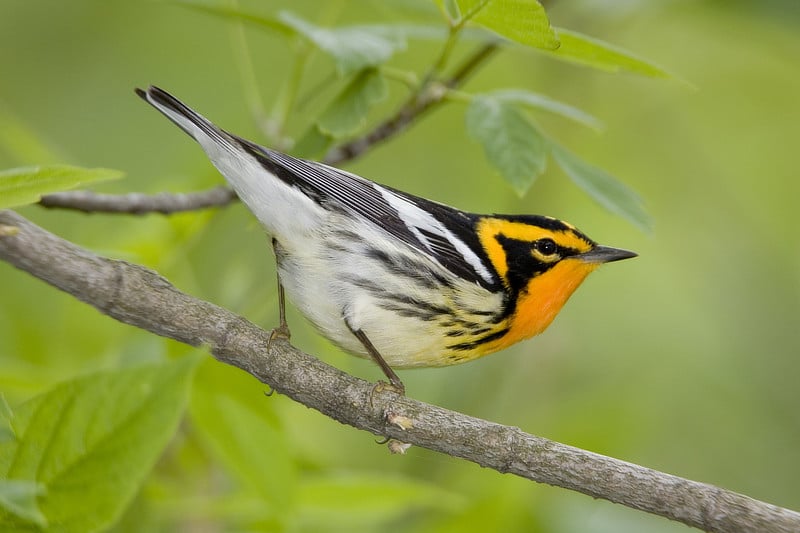
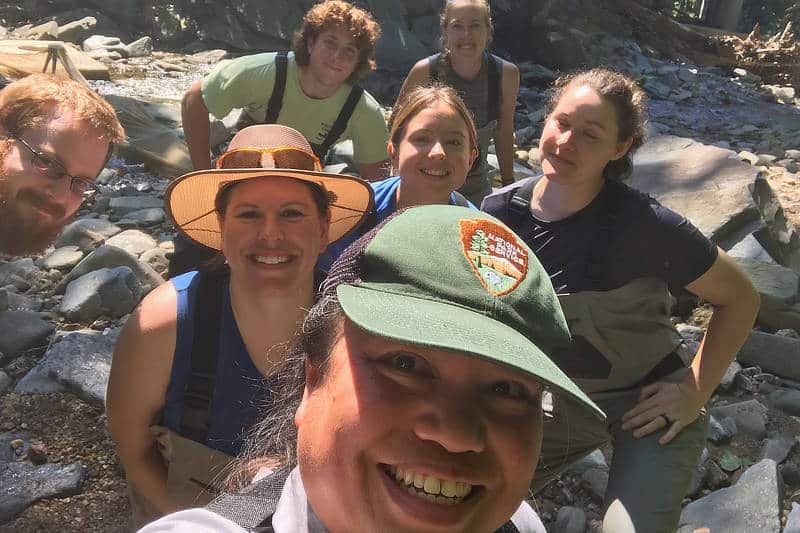

According to Liz Matthews, Ph.D., program manager and ecologist for the park service, park managers might find success by engaging with stakeholders and community groups in the watersheds upstream of the parks.

Matthews says, “We can describe the patterns found in the data, what’s happening in park streams, and recommend ways for park managers to reduce road salt use within parks and how they might partner with their local jurisdictions and neighbors to benefit entire watersheds.”
She adds, “We can’t protect what we don’t understand. If we value our national parks, we have to invest in them, and part of that investment includes ecosystem monitoring to ensure that resource management decisions are based on the best available science.”
Ultimately, scientific research within national parks also may help regain some of what’s been lost from nature elsewhere, as collaborations like the ones between the park service, the Stroud Center, and NASA DEVELOP help community groups apply lessons learned to both public and private landscapes closer to home.
Get Involved
Interested in monitoring water quality in your area? Email us at communitysci@stroudcenter.org to become a community scientist today.

